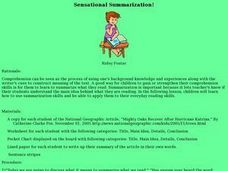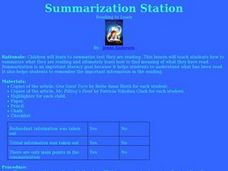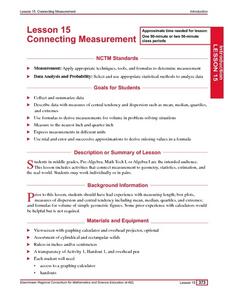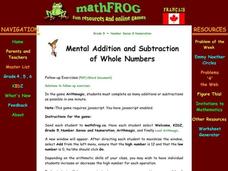Curated OER
Summarization Superstars
How do you read when you know you're going to be summarizing a text? Summarize a nonfiction text with your upper elementary schoolers. Your pupils independently read a nonfiction article and write a summary paragraph using the six-step...
Curated OER
Homemade Political Parties
Use this 5-day lesson to clarify the platforms of the two major parties, comparing and contrasting against students' beliefs. Begin by looking at unlabeled summaries of both party platforms, having learners identify most with one. Groups...
Curated OER
Presidents: Bibliography
Give credit where credit is due! After listening to a lecture/demo about why creating a bibliography is important, what should be included in a bibliography, and how to craft a bibliography, class members draft one for their own research.
Curated OER
San Agustin y La Florida
Read about San Agustin, Florida, and the Spanish influence on the American city during the 1500's. The text itself is five paragraphs long, and there is a bolded list of words that the reader needs to place correctly in the text. To...
Curated OER
It's Raining Meatballs
Students observe and demonstrate the process of summarization using the book "Cloudy With a Chance of Meatballs" by Judi Barrett. They silently read the story, and as a class discuss the five W's. Students then write a short summary of...
Curated OER
Sensational Summarization!
Students observe and demonstrate a variety of summarization strategies. They silently read an article from National Geographic Kids, and as a class write a summary that includes the main idea and details and the five W's. Students then...
Curated OER
Pigs: A Visual Splendor
Third graders practice using visualization to aid in their reading comprehension. After a reading a chapter from the book "Charlotte's Web," students write a brief summary of the plot using their visualizations, aided by reading...
Curated OER
Summarization Station
Pupils observe and demonstrate a variety of strategies for summarizing text. They read and discuss the five steps of summarization, silently read an article, then observe the teacher write a summary paragraph for the article. Students...
Curated OER
Connecting Measurement
Students participate in activities the connect measurement to geometry, statistics, estimation, and the real world. They collect measurements from their elbow to the tip of their middle finger and make a box plot of the data as well as...
Curated OER
Measures of Central Tendencies: Quartiles
In this statistics worksheet, students calculate the mean, median, mode, range, lower quartile, and upper quartile for 10 questions and interpret a box and whiskers graph.
Curated OER
Organizing and Interpreting Data
In this organizing and interpreting data activity, learners solve and complete 10 different problems related to reading various data tables. First, they complete the 3 charts shown with the correct tally amount, frequency amount, and...
American Chemical Society
Why Does Water Dissolve Sugar?
Did you know that if you wait long enough, the M on the outside of an M and M will float to the surface when submerged in water? Learners observe the sugar coating of an M and M while it is dissolving in water. They explain how this...
Curated OER
Mental Addition and Subtraction
Students play the online game ArithmAttack to practice mental math skills. They play the game to as many additions or subtractions as possible in sixty seconds. Afterward, they complete a paper based follow up exercise.
Curated OER
Fun with Summarizing
Students practice summarization by creating a story map. After reading Freckle Juice, students working in groups, create a story map of the main events of the story. Groups use their story maps to summarize a chapter of the story and...
Curated OER
Get the Skinny! Summarize a Story!
Learners examine the steps of summarizing text. They silently read an article, then read and discuss the steps to summarizing a passage. Students then write a summary of the article they read, and as a class discuss the main idea,...
Curated OER
Being Equal is No Monkey Business
First graders study what an equation is before working to determine how to divide an odd number of items in an equitable way. They divide equations into those that are true and those that are not while two students act as the king and...
Curated OER
Shakespeare Play Summaries in Four Words
This online interactive quiz on 10 Shakespeare plays is unlikely to be useful for your class; however, you could use it as a basis for your own assignment that asks class members to come up with four words to describe an entire work. An...
Ideas From Suzi
Responding to Literature
Guide your class through a text with resources for before and after reading. Learners ask questions, discuss characters and plot points, point out elements of the reading that stood out, and compose brief summaries.
Curated OER
Subtraction With Integers
This thorough introduction to the concept of subtracting negative integers walk learners through the necessary steps using teacher modeling and guided practice. Number lines and various word problems are used to support understanding of...
Statistics Education Web
Did I Trap the Median?
One of the key questions in statistics is whether the results are good enough. Use an activity to help pupils understand the importance of sample size and the effect it has on variability. Groups collect their own sample data and compare...
Curated OER
Communication, Day 5: Saying "No"
There are many ways to say, no. Secondary special needs students need to know when and how to say no when they feel they are in an uncomfortable situation. They sign, say, and role-play how to say no. Worksheets and role-playing cards...
Channel Islands Film
First Contact: Lesson Plan 4 - Grades 5-6
After watching Treasure in the Sea, a documentary about Channel Islands National Park and the video First Contact, about the voyage of Juan Rodríguez Cabrillo to the Channel islands, groups research and then compare the experiences of...
Curated OER
Relationships, Day 5: Acquaintances & Strangers
It is important for special needs students to know the differences between acquaintances and strangers. They define the world helper, acquaintance, and stranger then discuss a scenario based case study.They talk about touch and no touch,...
Curated OER
Do Touch!
Students explore the sense of touch. They investigate unknown solids using the sense of touch. Pupils use their senses of touch to match feely gloves. Students explore body parts, by tracing their hands and feet on paper. They create a...

























